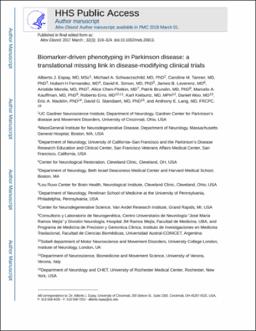| dc.description.abstract | Past clinical trials of putative neuroprotective therapies have targeted PD as a single pathogenic disease entity. From an Oslerian clinicopathological perspective, the wide complexity of PD converges into Lewy bodies and justifies a reductionist approach to PD: A single-mechanism therapy can affect most of those sharing the classic pathological hallmark. From a systems-biology perspective, PD is a group of disorders that, while related by sharing the feature of nigral dopamine-neuron degeneration, exhibit unique genetic, biological, and molecular abnormalities, which probably respond differentially to a given therapeutic approach, particularly for strategies aimed at neuroprotection. Under this model, only biomarker-defined, homogenous subtypes of PD are likely to respond optimally to therapies proven to affect the biological processes within each subtype. Therefore, we suggest that precision medicine applied to PD requires a reevaluation of the biomarker-discovery effort. This effort is currently centered on correlating biological measures to clinical features of PD and on identifying factors that predict whether various prodromal states will convert into the classical movement disorder. We suggest, instead, that subtyping of PD requires the reverse view, where abnormal biological signals (i.e., biomarkers), rather than clinical definitions, are used to define disease phenotypes. Successful development of disease-modifying strategies will depend on how relevant the specific biological processes addressed by an intervention are to the pathogenetic mechanisms in the subgroup of targeted patients. This precision-medicine approach will likely yield smaller, but well-defined, subsets of PD amenable to successful neuroprotection. | en_US |


